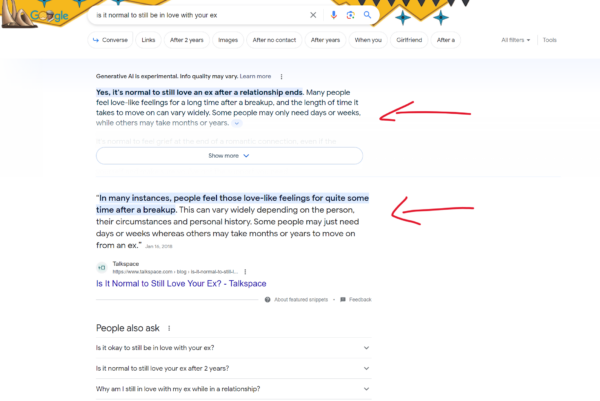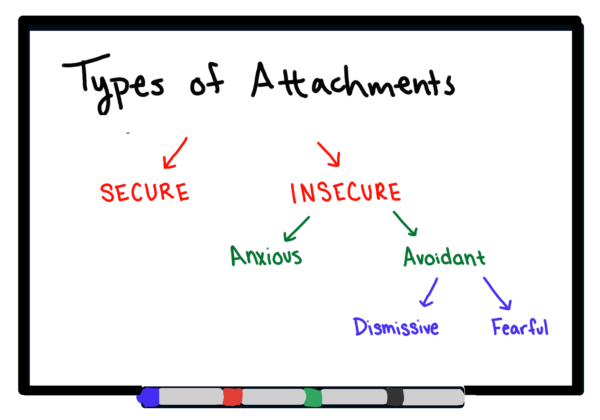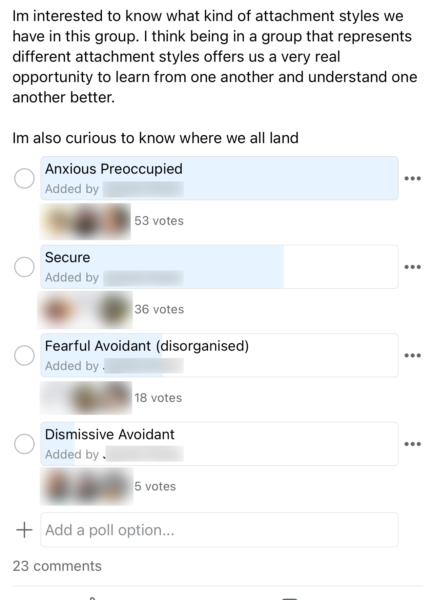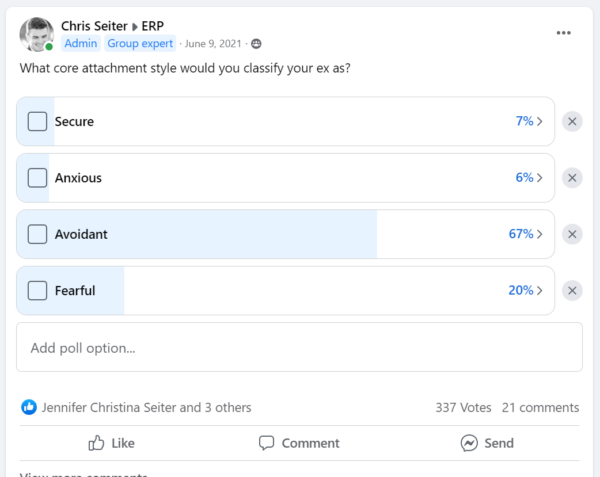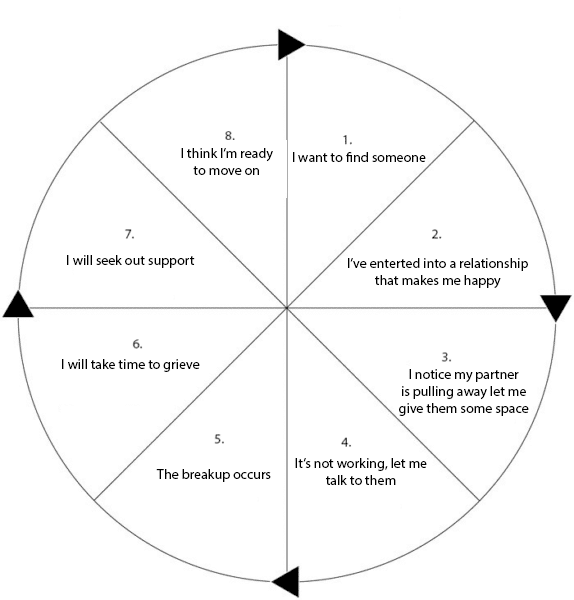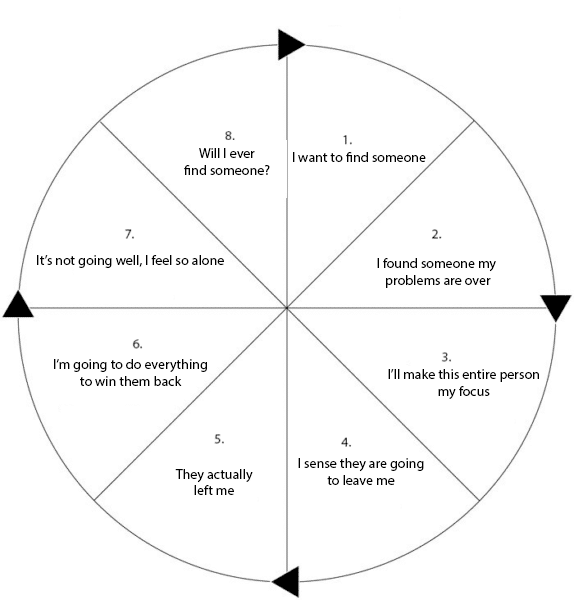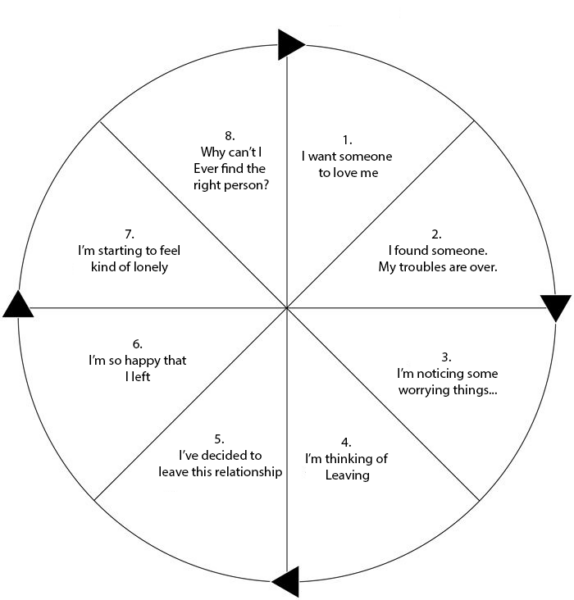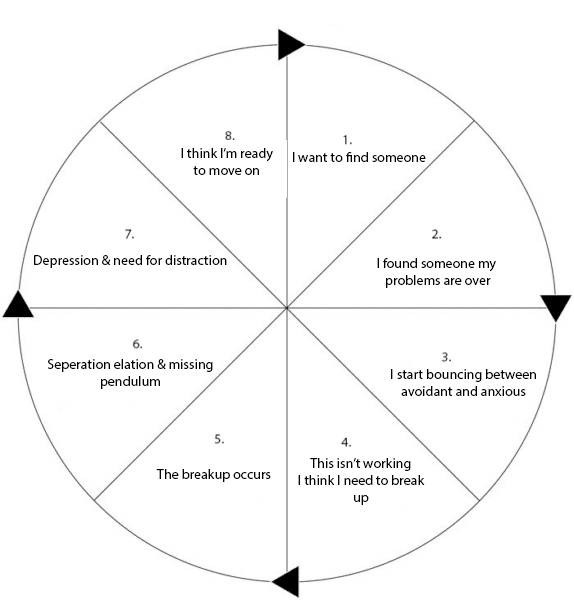The question of whether it’s normal to still be in love with an ex is a complex one, as it touches on the psychological aspects of attachment, the process of moving on, and individual differences in how people cope with breakups.
So, anyone who thinks they’re going to get a “one size fits all” answer to this is probably in for a rude awakening and that’s kind of the problem with online expectation now isn’t it? We all expect a simple bite sized for everything.
Even typing this query into Google gives us a bite sized answer,
But when it comes to love well, a bite sized answer becomes too complicated to give. You have to consider all kinds of factors,
- Your emotional attachment to the person
- The way the breakup ended
- Your personal grieving process
- Idealization of the past
- Societal factors
- New relationships
- Self reflection
But I actually think a better judge of how “normal” it is to be in love with your ex is by taking a look at your attachment style.

What Are Your Chances of Getting Your Ex Boyfriend Back?
Take the quizAttachment Theory And Its Relation To Heartbreak
I believe that attachment theory can give us an idea of how normal it is to still be in love with your ex.
So, what is attachment theory?
Well, attachment theory helps us understand how people process difficulties throughout their lives, whether that’s relationship issues or other hardships. Now, if you want the technical definition, attachment theory is a psychological, evolutionary, and ethological theory concerning relationships between humans.
Typically speaking, there are four main attachment styles:
- Secure attachment
- Dismissive-avoidant attachment
- Fearful-avoidant attachment
- Anxious attachment.
Out of those four, three are considered insecure attachments:
- Avoidant
- Fearful-avoidant
- Anxious
The end goal for every single human being on this earth is to end with what they consider to be a secure attachment style. It’s to take those three insecure attachment styles and try to do things or create healthy habits to become more secure over time.
Yet, if we’re trying to figure out how normal it is to still be in love with your ex, I would argue that understanding how each of these core attachment styles handles breakups can give us some insight.
But first, let’s look at some evidence. I’ve conducted multiple polls over the years with our audience, basically asking them, “Hey, what do you think your attachment style is?” and “Hey, what do you think your ex’s attachment style is?” The answers are pretty interesting.
Let’s take a look at our clients first.
Our Clients:
- 47% Anxious
- 32% Secure
- 16% Fearful Avoidant
- 5% Dismissive Avoidant
Now, when you compare that to our clients’ exes, the numbers are vastly different.
- 67% of our clients believe that their exes have a dismissive-avoidant attachment style
- 20% believe their exes have a fearful attachment style
- 6% anxious
- 7% secure.
Notice the vast difference. It’s a bit more spread out when people are rating themselves, yet when it comes to identifying exes, they consistently say that their ex is either avoidant or fearful-avoidant—close to 90% of the stats point that way.
Now, is that the truth? I’m not so convinced. I always cite this research because this is what the research gave us, but I would argue that many people misdiagnose their ex’s fearful-avoidant tendencies when, in reality, they are simply dismissive-avoidant. But I’m getting a little off-topic here.
I think by understanding each of these four core attachment styles and how they operate during a breakup, we can gain insight into how normal it is for them to still be in love with their ex.

What Are Your Chances of Getting Your Ex Boyfriend Back?
Take the quizAnd we’ll start first with probably the easiest one, and that is the secure individuals.
The Secure Individual
Now, I’ve become somewhat famous for my work on the concept of a “death wheel,” which is essentially the self-fulfilling cycle or even negative feedback loop that each individual attachment style finds itself caught up in when you look at the life of a relationship from the beginning to the end.
But understanding the journey that one particular attachment style goes through when they experience this death wheel will help you understand how likely it is they are to be in love with their ex.
All right, so what does it mean to be a secure individual? Well, what I find interesting is that it forces you to take a bird’s-eye view of attachment theory itself.
So, like I said, there are essentially two categories of attachment styles: secure and insecure. Now, what’s the difference between the two?
The secure one doesn’t usually have a core wound that can trigger insecure behavior. They tend to be very—I don’t want to say elevated individuals—but they are often patient, understanding, caring, and confident. And the one thing that I think separates the secure individual from the insecure ones is the absence of a core wound.
The core wounds, when we start talking about some of the insecure attachment styles, are going to be essential for helping you understand what triggers that attachment style.
Okay, so what does the life of a relationship look like if you’re with someone who has a secure attachment style?
- Well, like everyone, the secure individual, when single, wants to find someone. That’s stage one.
- Stage two is they enter into a relationship that they believe makes them happy.
- Stage three is when they start noticing that their partner is pulling away, so they decide, unlike the other insecure attachment styles, to give that partner some space.
- Stage four is when they recognize that the space they’re giving isn’t working, so they talk to their partner and try to bring the problems to the forefront to see if they can fix them.
- If that doesn’t work, stage five is essentially where a breakup occurs.
- Stage six is where the secure individual takes time to grieve.
- Stage seven is when they start to seek out support, which can be found through friends, family, communities, therapists, psychologists—you name it.
- And then stage eight is when they’ve healed, allowed themselves to grieve, sought support, and are ready to move on. This leads them back to wanting to find someone else.
Now, I think the end goal for all people in relationships is to essentially never get out of the cycle where they stay in the first half of the circle.
I believe the secure person has it right: they want to find someone, they’ve entered into a relationship that makes them happy, they notice their partner pulling away a bit, they give them some space first, and then if that doesn’t work, they talk to them.
Ideally, this keeps you on the right side of the “death wheel,” so to speak.
So ultimately, the whole point of taking you through the lifeblood of a secure relationship is to show that, in my opinion, these are the people who are least likely to be hung up on an ex and in love.
They handle breakups maturely and use them as an opportunity to heal and grow. So, usually, not that they can’t still love their ex, they can maintain vast respect and even friendships with exes, but they tend to have enough confidence in themselves to not get caught up in a toxic situation.
They’re ready to move on, they do move on, and they continue to find people from whom they can grow and learn. So, yes, I think if you’re dealing with an ex or you have a secure attachment style, then you’re the least likely to be hung up on an ex and still be in love.
The Anxious Individual
Remember what I was talking about with core wounds and how I said that for the insecure attachment styles, they tend to be incredibly important to understand?
Well, a core wound is something that triggers an individual.
For the anxious individual, the core wound is a fear of abandonment, meaning they’re terrified that they will be left and abandoned throughout the entirety of the relationship.
This often leads them to seek constant reassurance, and if their greatest fear does come true, they end up not only seeking more reassurance but also trying to fix things.
The way they decide to fix things is by begging for their exes back, sometimes through Facebook stalking, sometimes actual stalking, and it all comes from a place of severe anxiety.
Now, let’s look at their journey in a relationship.
- For them, just like all the other attachment styles, they want to find someone.
- Stage two is they find someone and they believe their problems are over.
- Stage three is they decide to make this person their entire focus. What’s interesting is that this act of making the person their entire focus tends to turn off their partner
- Which can lead to stage four: they start sensing they’re going to be left.
- Then stage five occurs, where the partner actually does leave them.
- And then stage six occurs, where the anxious individual decides to do everything they can to win their ex back. Sometimes that works out for them, and they start the entire cycle over again; sometimes it doesn’t. If it doesn’t work out, they move on to stage seven,
- Which is: it’s not going well, I feel so alone.
- And then stage eight is where full-on depression kicks in: Why is this always happening to me? Will I ever find someone? And that leads them right back to the beginning, either trying to get their ex back again, find someone like their ex, or they find a new person to put into this cycle.
In my opinion, the verdict on this one is that the anxious individual is the most likely to still be in love with their ex immediately after a breakup.
You can see right off the bat that their first reaction upon going through a breakup isn’t to allow themselves time to grieve; it’s to not give their ex space. They decide to do everything they can to win their ex back.

What Are Your Chances of Getting Your Ex Boyfriend Back?
Take the quizBecause in their mind—and it’s important to understand this—anxious individuals tend to be in very codependent relationships. So for them, it feels like their entire world is falling apart because their world revolves around the sun that is their ex.
And if the sun suddenly blinks out of the sky, of course, it’s going to cause some problems, and they’re going to do everything they can to win that ex back.
This is why I think that if you have an anxious attachment style, you’re the most likely candidate to still be in love, and it’s normal to be very much in love with your ex after a breakup.
The Dismissive Avoidant Individual
What about dismissive-avoidant individuals, though?
The dismissive-avoidant individual is the one I’ve studied the most here at Ex-Boyfriend Recovery. As you saw in the research I cited above, around 67% of our clients believe that their exes are dismissive-avoidant.
And a lot of the studies I’ve done on dismissive-avoidant individuals tend to be pretty accurate. I do think that most of the exes we’re looking at here are dismissive-avoidant. So what does that mean?
Well, the core wound of someone with a dismissive-avoidant attachment style is that they value independence above all else. So if their independence is threatened, that’s when they tend to either avoid a situation, break out of a situation, or avoid conflict.
I always say that dismissive-avoidants each have a different trigger point.
For some, asking them to move in doesn’t trigger them; there’s a certain threshold that does. For others, maybe going ring shopping is what triggers them. They start to feel, “Hey, I’m losing my independence here.” This is another reason why sometimes, when there are accidental pregnancies, the guy suddenly bails because suddenly his independence is being taken away. So that’s the core wound in theory.
Their journey around the “death wheel” is particularly interesting.
- Like all others, they start out wanting someone to love them.
- Then, stage two, they find someone and convince themselves that their troubles are over.
- Stage three is when they start noticing some worrying things. The most common pairing we see in our research is that our clients tend to be anxious, and their exes tend to be avoidant, resulting in an anxious-avoidant pairing. For the dismissive-avoidant, stage three is when they start noticing that the anxious partner is making the avoidant their entire focus, which freaks them out because it triggers their need for independence.
- Stage four is when the avoidant starts thinking of leaving.
- Stage five is when they decide to leave the relationship.
- Stage six is when they’re incredibly overjoyed and happy that they’ve left the relationship—I also call this the “second honeymoon period.” They go through a separation elation where they’ve finally regained their independence.
- Stage seven is when, over time, they start to feel a little bit lonely.
- And stage eight is when they wonder, “Why can’t I ever find the right person?” and a bit of depression kicks in.
Okay, there are a couple of other elements that are important to understand about dismissive-avoidants before I give you the verdict on how likely it is that a dismissive-avoidant will still be in love after a breakup.
Dismissive-avoidants are interesting because they actually prefer the concept of the “phantom ex.”
The phantom ex is essentially the one that got away, the one person in their head that they’ve built up to be the one they always regret not trying with. It’s a paradox because they like relationships where they don’t have to be present. So for them, the ideal relationship is one they can romanticize from afar.
Over time, what I’ve found with dismissive-avoidants, especially with our clients, is that when I tell my clients it’s time to move on, that’s when the dismissive-avoidant suddenly comes back into the picture and wants to try again.
This is because they’ve started to paint their ex as the phantom ex. I did an entire video where I walked through this mentality, explaining what a dismissive-avoidant ex missing you actually looks like. Essentially, it revolves around the dismissive-avoidant feeling like you’ve moved on enough for them to feel comfortable enough to miss you.
This is important for our verdict because I think initially, the dismissive-avoidant will not feel like they’re in love with you after the breakup.
But over time, as they see you move on, they start to paint you as the phantom ex, and that’s when they begin to have nostalgic reverie. They start to fall in love with you from afar, and that’s when they start to crop up again.
The Fearful Avoidant Individual
The fearful-avoidant attachment style is particularly challenging because it encompasses both the core wounds of an anxious individual and an avoidant individual.

What Are Your Chances of Getting Your Ex Boyfriend Back?
Take the quizThese tend to be the rarest attachment styles globally, often feeling like you’re conversing with two entirely different people within one person. One moment, you’re dealing with someone who appears to be an incredibly anxious individual, and the next, you’re facing someone who seems to be a completely avoidant individual.
I liken the behavior of a fearful-avoidant to a pendulum swinging: on one end, you have the avoidant side, and on the other, the anxious side.
Their behavior can swing from incredibly anxious to incredibly avoidant and back again, depending on their actions and life circumstances.
Their journey around the “death wheel” is quite erratic.
- Like the others, they start at stage one, wanting to find someone to love them.
- At stage two, they find someone and believe their problems are over.
- Stage three sees them bouncing between anxious and avoidant behaviors within the relationship, creating friction.
- Then, at stage four, they decide that the relationship isn’t working and that they need to break up.
- Stage five is the breakup itself.
- Stage six involves them swinging from the separation elation typical of the avoidant side to suddenly reaching out and missing you. Once they receive some nurturing from you, they revert to separation elation and disappear again.
- Stage seven is what I call “depression and a need for distraction.” They oscillate between being incredibly depressed, unable to get out of bed, and then, perhaps the next moment, they’re out at a party, exhibiting seemingly erratic behavior.
- Finally, stage eight is when they decide they think they’re ready to move on, which leads them back to the beginning, and the cycle continues.
In my opinion, it is normal for a fearful-avoidant to still be in love with you, but it won’t be a stable kind of love.
It will be akin to repeatedly turning a light switch on and off. It’s crucial to understand that these individuals are incredibly rare.
Most of the time, you’ll be dealing with dismissive-avoidant, anxious, or secure individuals.
Fearful-avoidants aren’t the norm!
